Before you bake your first gluten free recipe, you need to undertake a gluten free flour comparison, since the foundation of any baking recipe is flour — in our case, gluten free flour.
How do you know what gluten free flour or blend combination is best for which recipe? Should you blend your own or buy a pre-mixed gluten free flour blend? Read on for how to make a smart gluten free flour comparison.
Gluten Free Flour Blends
When we used to bake with gluten flours (aka wheat flour), it didn’t matter which brand you bought off the grocery store shelf, they were all pretty much the same. Gold Metal brand or store brand — your recipe would turn out the same.
With gluten free baking, you have to throw that notion out the kitchen window. No two gluten free flours or gluten free flour blends are at all the same, and you can’t simply take one gluten free flour (like rice flour) and use it in place of gluten (aka wheat) flour; it just won’t work.

With that in mind, you’re going to need a BLEND of gluten free flours and most likely also some kind of binder to mimic the gluten that we’re missing. That binder will hold the baked goods together, and without it, most recipes will crumble to sad bits.
Most bakers recommend using either xanthan gum, guar gum or psyllium husk, in varying and very small amounts (more on gums in this article here).
Top Gluten Free Flours For Baking
Remember when I told you that no two gluten free flour blends are the same? That fact is in part due to the fact that there are well over 20 gluten free flours which are fairly commonly available — I actually lost count at 23.
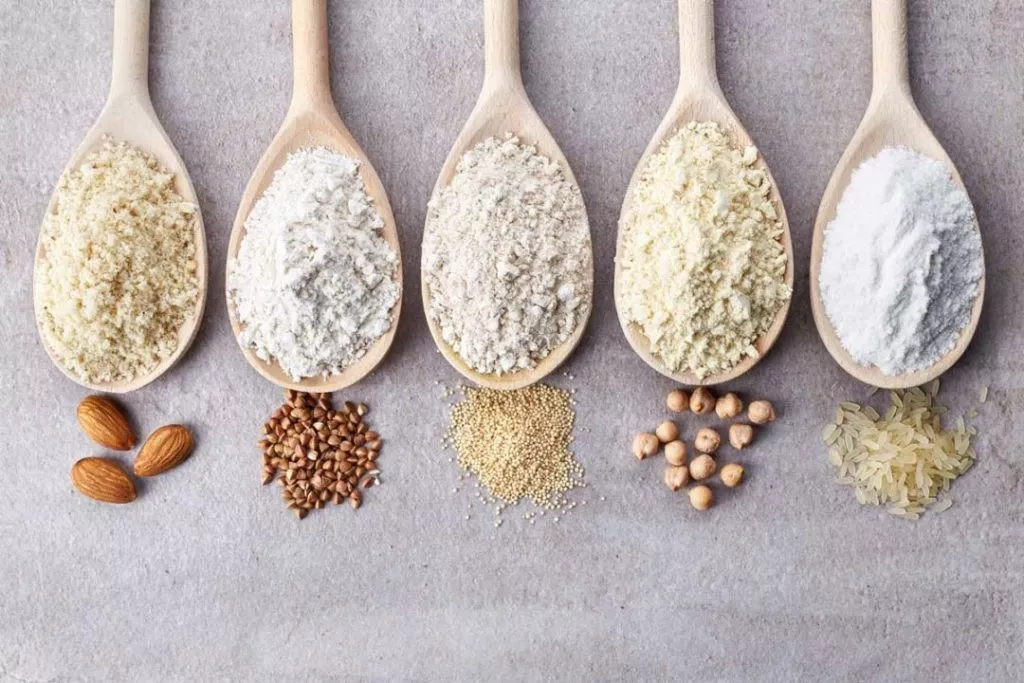
Gluten free flours include everything from ubiquitous rice flours to nut flours like almond, peanut and even acorn, to seed flours like millet and quinoa to insect flours like cricket (yes, I said cricket!). It seems that with a certain amount of ingenuity, you could make flour out of nearly anything!
Gluten Free Flour List
Almond Flour (Paleo, Grain-Free)
When the skins are removed from almonds, they can be ground into a gluten free and grain free, high fat flour. Almonds provide a pleasant taste, but do come with a texture, as well. Baked goods will be denser and heavy and often require an extra egg to hold together without crumbling.
Arrowroot Flour (Paleo, Grain-Free)
Arrowroot is a pure, tasteless starch derived from the arrowroot plant. Similar to cornstarch, it’s used in combination with other gluten free flours or for thickening and to add crunch.
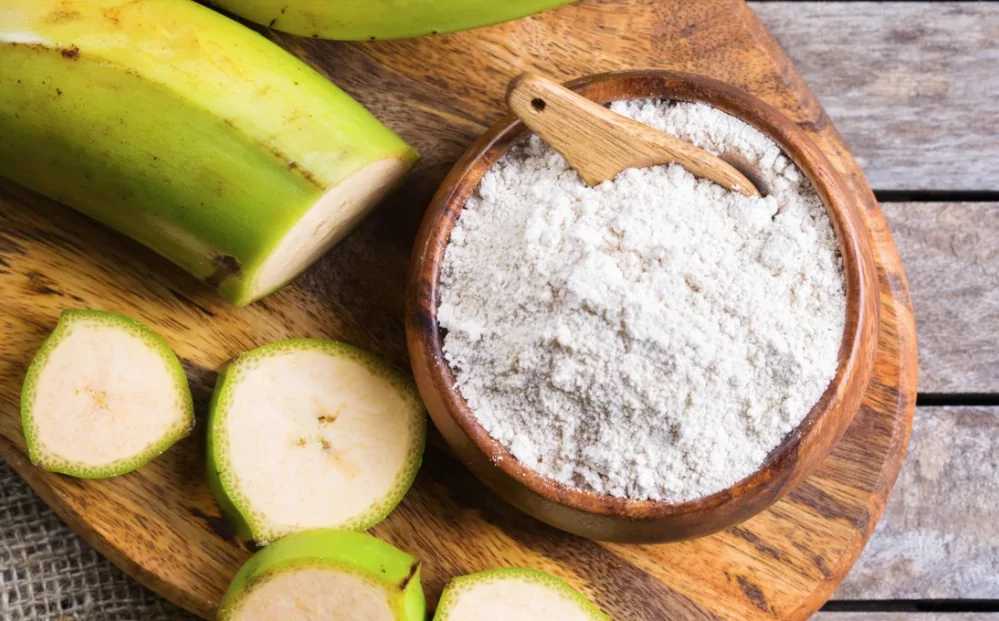
Banana Flour (Paleo, Grain-Free)
This healthy resistant starch is a fine powder grain free flour made from dried, ground green bananas. It has an earthy, but mild taste.
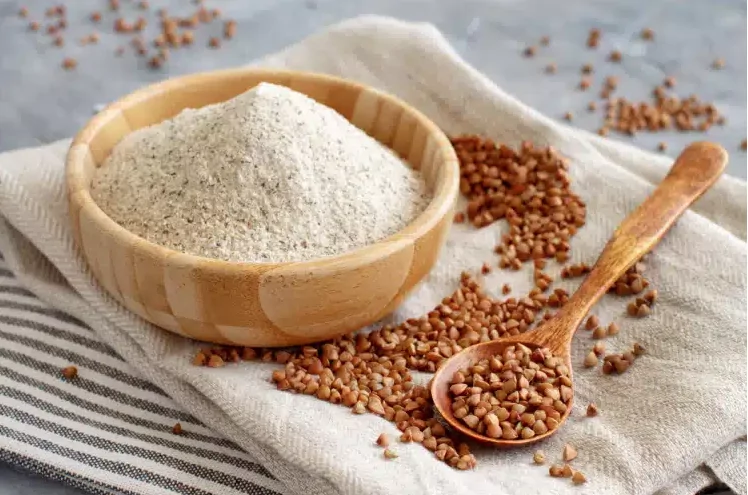
Buckwheat Flour
Despite its name, there is no wheat in buckwheat flour. Buckwheat is a pseudocereal actually closely related to rhubarb. In baking, buckwheat flour can be earthy and even taint baked goods with a gray color if used in high proportion.
Cassava Flour (Paleo, Grain-Free)
Cassava is starchy tuber or root vegetable that when grated and dried, is made into cassava or yuca flour. It is neutral in flavor and offers beneficial resistant starches.
Chickpea Flour
Chickpeas are legumes (also called garbanzo beans). When dried, chickpea flour (or gram flour or besan) makes a grainy, nutty tasting flour that can be useful in certain traditional Middle Eastern recipes, in particular. Because this flour is dense, it will prevent baked goods from rising and should be combined with other gluten free flours for best results.
Coconut Flour (Paleo, Grain-Free)
We’re all familiar with coconut, but to make it into flour, it is first defatted. It retains some of coconut’s unique flavor, and is high in fiber. It’s also a grain free baking flour. It requires much more liquid in recipes than typical flours, and often requires additional eggs to prevent baked goods from crumbling.
Corn Flour & Corn Starch
Corn meal (polenta) when ground down more finely is made into corn flour, both of which are high in protein and anti-oxidants. When stripped down to pure starch, it’s the product we know as corn starch which is useful for thickening. Corn starch does not absorb liquid as rapidly as other starches like potato starch and tapioca starch.
Flaxseed Meal
When ground into meal, flaxseed meal is very much like a flour and provides excellent binding properties. Flaxseeds come in darker and lighter, golden varieties. It’s best to grind your own if you can, as this meal goes rancid quickly if not used or refrigerated due to the oils in the product.
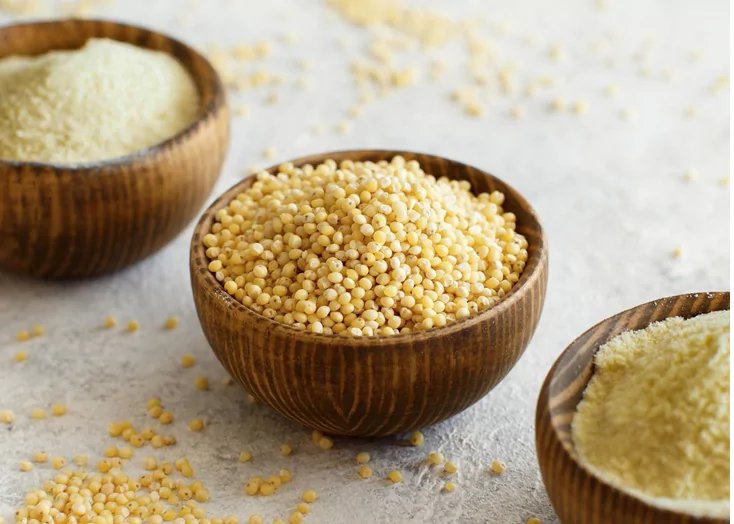
Millet Flour
Millet is a mild flavored and light colored cereal grain. It’s higher in protein than brown rice flour and very versatile, making its way into everything from cereal to gluten free beer. Add to gluten free muffins in its whole grain form for a nutty crunch or grind into flour and add up to 25% for a whole grain flour addition.
Oat Flour
Oat flour is a wonderful all-purpose flour that is mild in flavor and relatively light, given its whole grain basis. Make your own gluten free oat flour by grinding certified gluten free, purity protocol oats in a food processor or blender until finely ground. Read more about gluten free oats and whether they’re right for your diet.
Potato Starch
Potato starch is NOT the same as potato flour. Potato starch is simply the readily absorbs liquid and has a neutral flavor and a good binding ability.
Potato Flour
Potato flour is made from the entire potato and is very absorbent in recipes, meaning that it will require more liquids added.
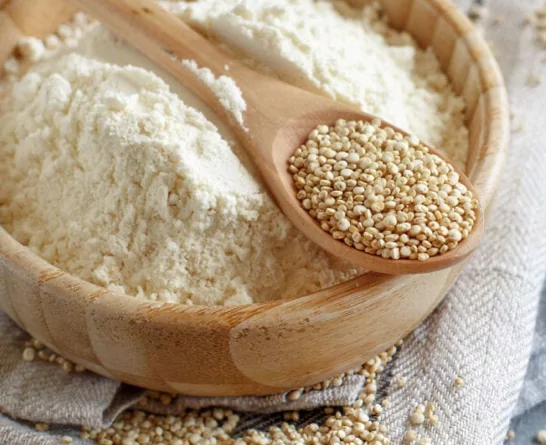
Quinoa Flour
Super healthy pseudocereal quinoa is high in fiber and protein and is often enjoyed on its own as a side dish in place of rice, but it can also be made into flour for baking, however, it’s not recommended in recipes above 25% proportion. It’s also difficult to source.
Rice Flours
Brown rice flour, white rice flour and sweet rice flour are all different kinds of rice flour. Brown rice flour is a whole grain flour containing the bran, germ and endosperm … it also makes baked gluten free baked goods gritty when used in large proportion. White rice flour has had the bran removed before grinding, yet can still be gritty unless a very find grind is used. Sweet rice flour is the starchy flour milled from short grain glutinous rice (it’s gluten free!) and it gives a sponginess to baked goods; it’s not interchangeable with other rice flours in recipes, as it’s a pure starch. In Japan, it’s known as Mochiko.
Sorghum Flour
Another whole grain flour, this ancient, nutritious cereal grain is heavy and dense and cannot be used in large proportion in recipes. It has a mild flavor that some people like and others do not. Consider this when choosing which flours to use.
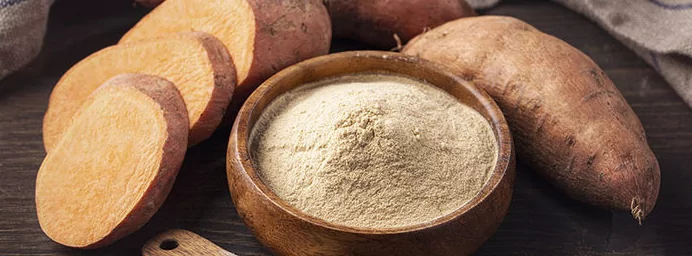
Sweet Potato Flour (Paleo, Grain-Free)
Sweet potato flour is exactly what you think it would be — flour made from cooked, dried sweet potatoes. It’s not a grain, so it’s in the paleo category and it’s high in fiber with a mild taste. It’s very expensive and should not be the only flour in your blend.
Tapioca Flour (Paleo, Grain-Free)
Tapioca starch or flour (they are the same thing) is made from the starchy liquid extracted from cassava root. It has no flavor and is very fine in texture. It is useful for thickening.
Teff Flour
Teff is the world’s smallest grain, but packs a ton of fiber and nutrition. It also has a distinct earthy taste. Use caution when adding too much teff flour, as it can cause foods to be gummy due to its extreme binding properties.
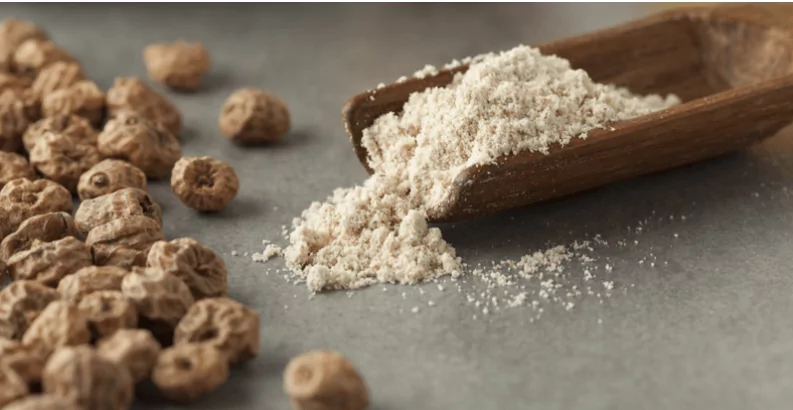
Tigernut Flour (Paleo, Grain-Free)
Tigernuts are not nuts at all, despite the name. They are extremely healthy tubers containing no gluten, nuts, or grains. Tigernuts contain fiber and protein, but also have a bit of a nutty flavor and when used in too high a proportion, can cause baked goods to be crumbly.
When baking with gluten free flours, you will need to add a binder to these flours in order to replicate the gluten that is absent from the blend, which is where gums and psyillium husk come in. Read more about these ingredients and how to add these in the correct proportion here.
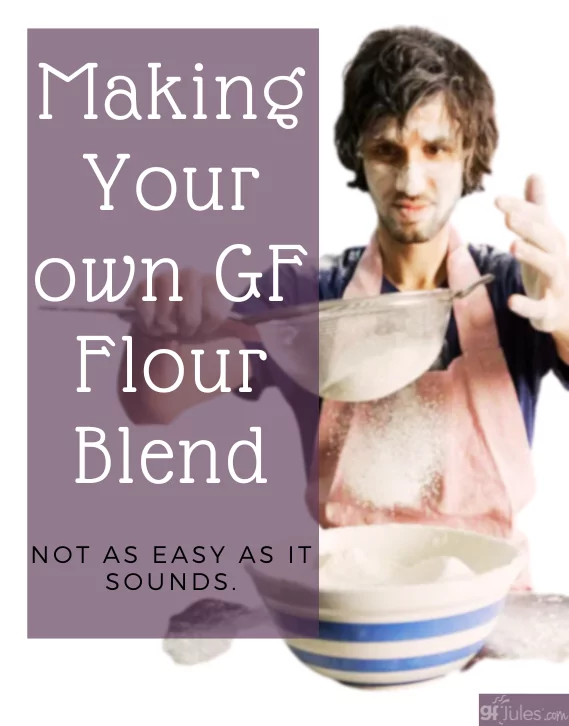
Gluten Free All Purpose Flour Blends
Not only are there so many different gluten free flours out there, but there are so many different combinations and proportions possible, that there’s no way that two blends could be similar, even when the ingredients may look the same. And it’s really, really difficult to get one to work in every recipe like your old all purpose wheat flour did. But it’s possible with just the right combination!
Bearing all those things in mind, when I field reader questions about recipes, I always ask what flour blend they’re using first. Results will vary incredibly, based upon blends. Don’t think the problem lies with you if your gluten free pie crust falls apart — it’s probably because of the gluten free flours you’re using. (See, it’s not you, it’s your flour!)

gfJules Flour
When I finally created (after two years of work!) a truly EVERY Purpose gluten-free flour that I could use just like I had my all purpose wheat flour before, I was back baking delicious foods again, for everyone! I was so excited to share delicious treats with friends and family — and to lick the bowl — that I ultimately started sharing my “Jules Flour” with tens of thousands of others living gluten-free because it was too good to keep just for myself!
Since its first release in 2007, I’ve re-worked my gfJules® Flour blend several times and perfected it and my gfJules Gluten Free baking mixes for optimum results. I’m proud to also share that it has now won #1 certified Gluten Free Flour 6 times in the consumer choice Gluten Free Awards.
But I still hear from folks every day who say they’ve looked at the label on my gfJules Flour and they think they mix a flour at home that’s the same thing. I appreciate that it looks easy and that they may have some similar sounding gluten free flours at home, but I promise you, it’s not at all the same.
It’s actually crazy how a tiny percentage difference makes a huge … well, difference! And again, that’s even if we were talking about the same raw ingredients, which we’re not.
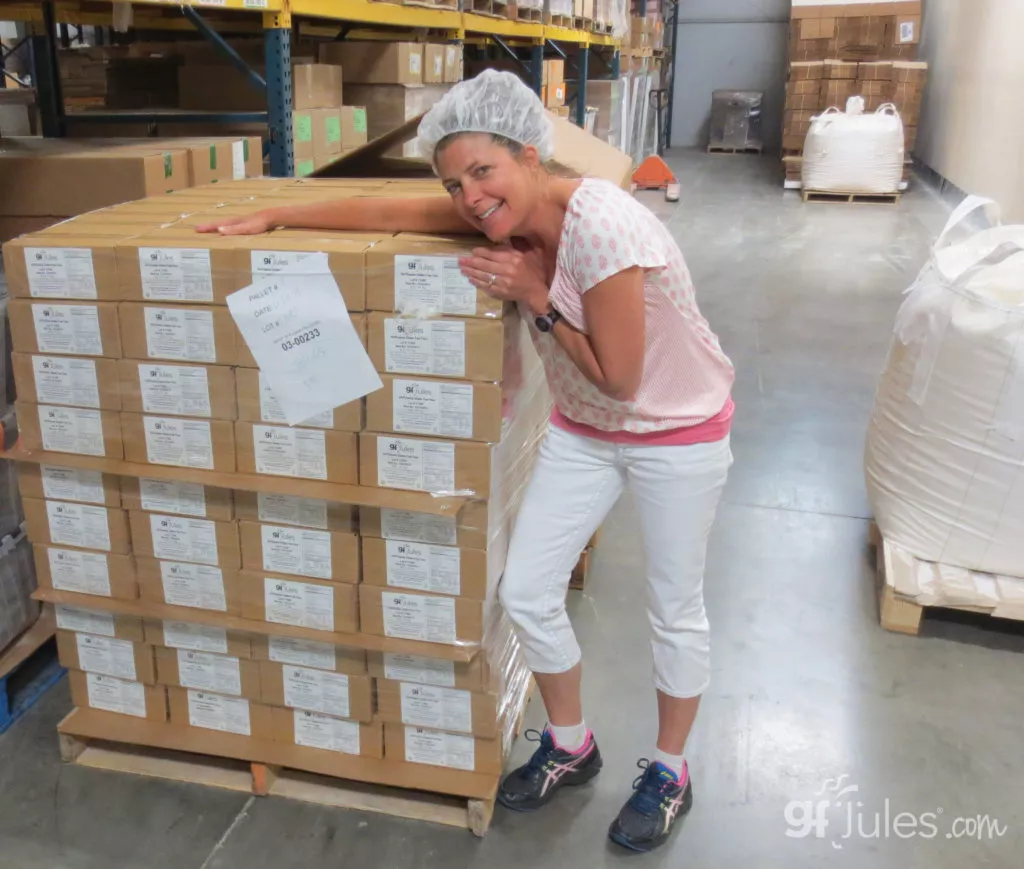
After years of experimentation, blending, tweaking, changing and improving (yes, I improve and tweak my gfJules Flour blend over the years as new raw ingredients become available!), I am confident that what I offer my customers is the safest, best gluten free flour on the market anywhere. It’s also now among the first products in the nation to be CERTIFIED Free From the Top 9 Food Allergens. That’s how seriously I take your family’s food safety.
I use ingredients that may sound ordinary, but they’re quite unique and are not available to individuals for purchase in stores. In the right proportions, this blend comes together to make a special mix that is truly all purpose, adds stretch to doughs, doesn’t crumble, doesn’t make your baked goods dry or gritty, adds shelf life to your breads and muffins, and doesn’t have a funny smell or color. It also works in every recipe, from cakes to cookies to muffins to breads to pies. In short, my gfJules Flour does what a great flour should, gluten free or not.
Does Gluten Free Flour Bake the same as all purpose flour?
In most cases, no, but with gfJules Flour, gluten free flour bakes the same as all purpose flour! That’s because gfJules® Flour is the best gluten free flour for all baking!
Here’s more on gluten free flours, what sets them all apart, why they’re all so different, and how to make your own blend if you can’t tolerate one or more of the ingredients in my blend:
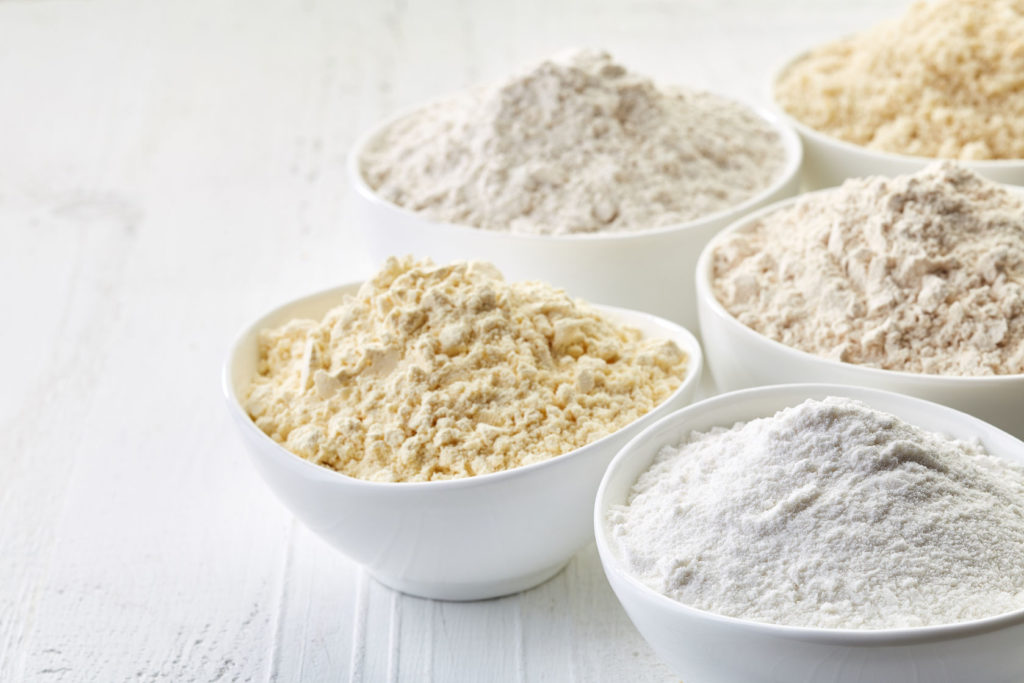
Using the right gluten free blend truly makes ALL the difference in your gluten free baking.
When you want to convert a favorite family recipe calling for wheat flour, or a gluten free recipe calling for several different kinds of flour, all you need to do is to use my gfJules All Purpose Gluten Free Flour. Simply total up the amount of flour called for in the recipe and use that amount of my gfJules Flour instead. Easy, right?
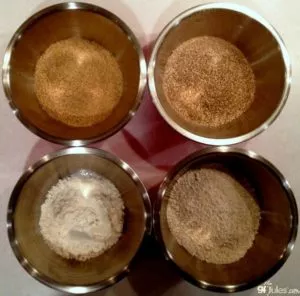
Top 10 Tips for Buying Gluten Free Flour Blends:
-
When reading ingredient labels, put the bag down if the first or second ingredient is rice flour — white or brown (but especially brown). That means that the blend is predominantly rice flour and it’s likely to be gritty and also to cause recipes to be dry or crumbly.
-
If the blend does not already include a gum or psyllium husk, then you’re most likely going to have to add it yourself, which is a bummer because a quality, gluten free gum can be expensive! It’s also important to only use the exact right amount of gums in any given recipe, since using too much of these gums in your baking will make your baked goods rubbery – read more about how to use these gums in your baking in my article on gluten free baking with gums
-
Do yourself a favor and don’t use any bean flours! They smell funny, they leave an odd aftertaste, and using them in your recipes means you’ll often need to add more sugar to mask those unpleasant characteristics! Choose clean flours that don’t have any taste and the flavors of your recipes will shine through.
-
For best results, steer clear of gluten free flours that have a funky aftertaste. Some other whole grain flours like amaranth, quinoa, sorghum, teff and others have distinct flavors which may or may not appeal to you. They will taste different than the all purpose wheat flour you are used to, though. Decide whether you like the taste and performance of these flours through experimentation, if you’re the kind of baker who likes to try new things. If not, know that these flours will taste different, which may not be what you had in mind.
-
If you’re using nut flours (like almond), lots of recipe modifications will need to be made to convert a traditional recipe to gluten free. Expect batters and doughs to be thick, add baking time, and reduce the fat in the recipe by around 25% to compensate for the fats already present in the nuts.
-
Blends that contain a lot of rice flour tend to be gritty. To combat that, make sure blends you buy or make have enough starches in it (corn starch, potato starch, tapioca starch, arrowroot powder …) to keep the end product light, instead of dense, heavy and gritty.
-
Many gluten free flour blends contain milk powder (dairy), nuts, or other food allergens which may not work for your family. Some new flours and mixes even include “gluten removed” wheat starch!!! Review ingredient labels closely, and know that there are alternatives if the blend you’re considering won’t work for you. My gfJules Flour (all of my products, actually!) are certified FREE FROM the Top 9 Food allergens (wheat, soy, egg, dairy, peanut, tree nut, fish, crustaceans and sesame).
-
Make sure the individual flours you buy or the blend that you buy is CERTIFIED gluten free and made in a dedicated gluten free facility. It can be hard to find these layers of safety in all flours and blends, but it’s important because flour is notoriously easy to cross-contact, due to its fine particle size. Here’s more information on identifying certified and safe gluten free products.
-
All kinds of recipes for all purpose flours are easy to find, although few of them are very good and many people still recommend that you need a different blend for different kinds of recipes which is exhausting, expensive, and unnecessary. It is overly burdensome to mix up a recipe for gluten free flour that is specific to each recipe, though many recipe authors prefer to specify different individual gluten free flours for each recipe. Several pre-mixed blends are available as well (my gfJules Flour is the one I recommend for my recipes on this site). If you try one that doesn’t work for you, try another — they are all created differently! Don’t get discouraged or feel too overwhelmed to bake now that you’ve gone gluten free. It can be quite easy and delicious when you have the right ingredients to take the guess-work out of it for you!
-
If you have other food allergies or sensitivities which precludes you from using a pre-made all purpose flour like my gfJules Flour, a good starting place to make your own homemade blend for cookies, cakes and quick breads is to use this ratio of whole grains to starches plus gum (keep in mind that the blend performs better when you use a mix of starches and whole grains, rather than just two flours in total – experiment and keep good notes!).

Corn-Free Gluten Free Flour
If you prefer to purchase a pre-made blend which suits your food allergies, I totally understand (it’s very handy!). You may have to tweak some recipes, as all blends are different — some require more liquid than others, for example.
I now offer a CORN-FREE Multigrain Biscuit & Breakfast Baking Flour and the the corn-free all purpose blend I recommend is Better Batter Flour. My gfJules Bread Mix is also corn-free.
Grain-Free Gluten Free Flour
If you’re baking GRAIN-FREE, my new NADA Grain-Free, Paleo Baking Flour was made just for you! Made without any of the top 9 food allergens, you can confidently use gfJules Nada Flour in the same proportion for all your recipes for cakes, cookies, pies, pancakes, tortillas, muffins and quick breads.
If you still have other dietary restrictions, here’s my suggested Homemade Gluten Free Flour Blend Ratio:
- 2 1/2 cups gluten free starch (choose at least one: cornstarch, potato starch, tapioca starch, arrowroot, sweet rice …)
- 1 1/2 cups gluten free whole grain flour (choose at least one: sorghum, millet, brown rice, buckwheat, white rice, sweet potato, almond, amaranth, teff, quinoa, coconut, purity protocol oat …)
- 3 teaspoons xanthan gum (some are made with corn) OR guar gum OR psyllium husk powder
- For yeast breads and pizza dough, you’ll want to change the ratio given above to equal parts starch and whole grain plus 1 teaspoon gum per cup of flour blend.
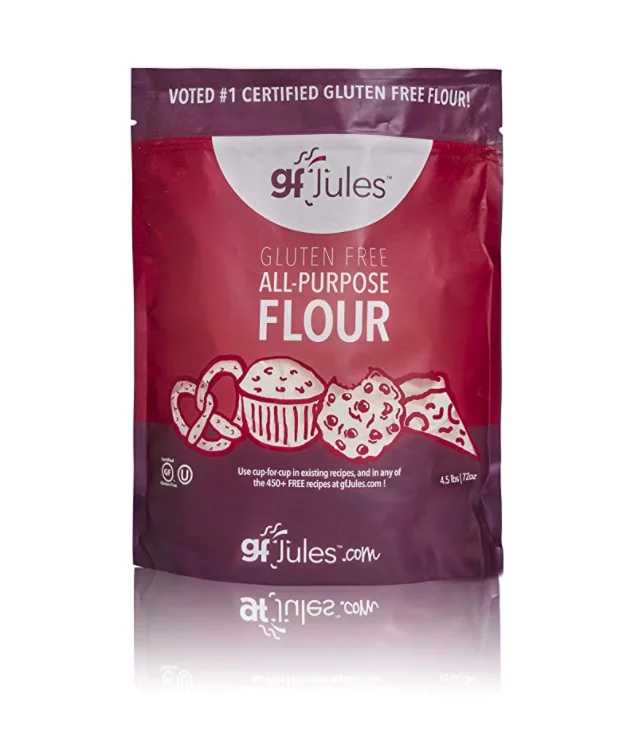
At the end of the day, don’t be daunted by all these recipes and ratios, though. I don’t make a new blend for every recipe anymore.
What I use EVERY day in ALL recipes is my gfJules Gluten Free All Purpose Flour. It takes the guess-work out of all of it; I know I can rely on it to work and it has been formulated with particular ingredients to keep baked goods fresher longer, and provide soft stretch to pastry crusts and doughs.
It truly makes gluten free life a lot easier. Pin this post to save for later!
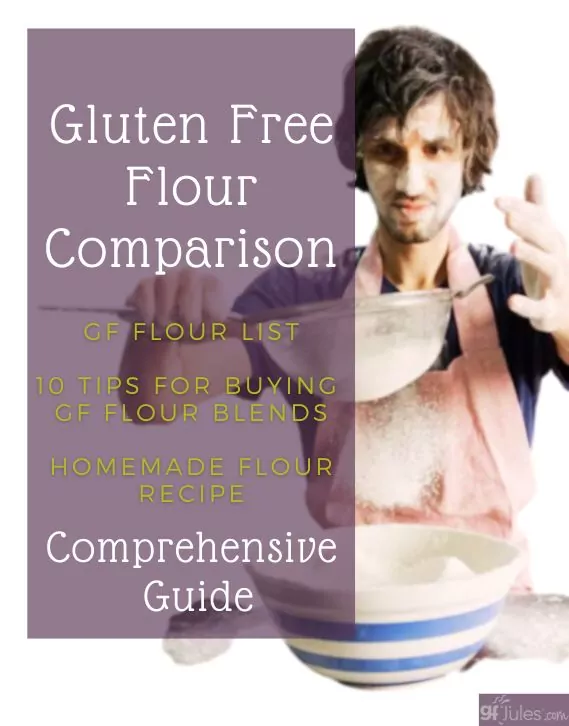
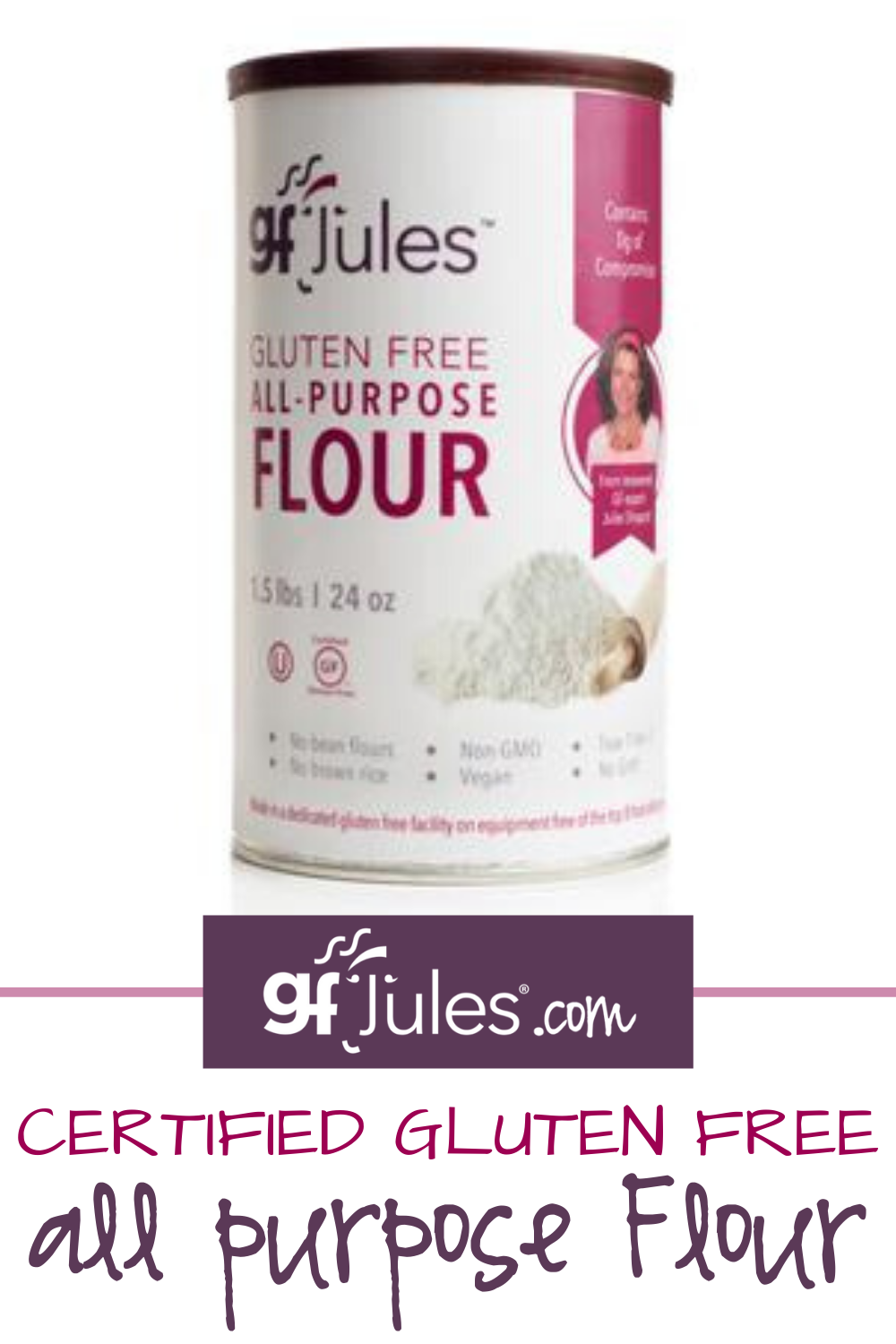


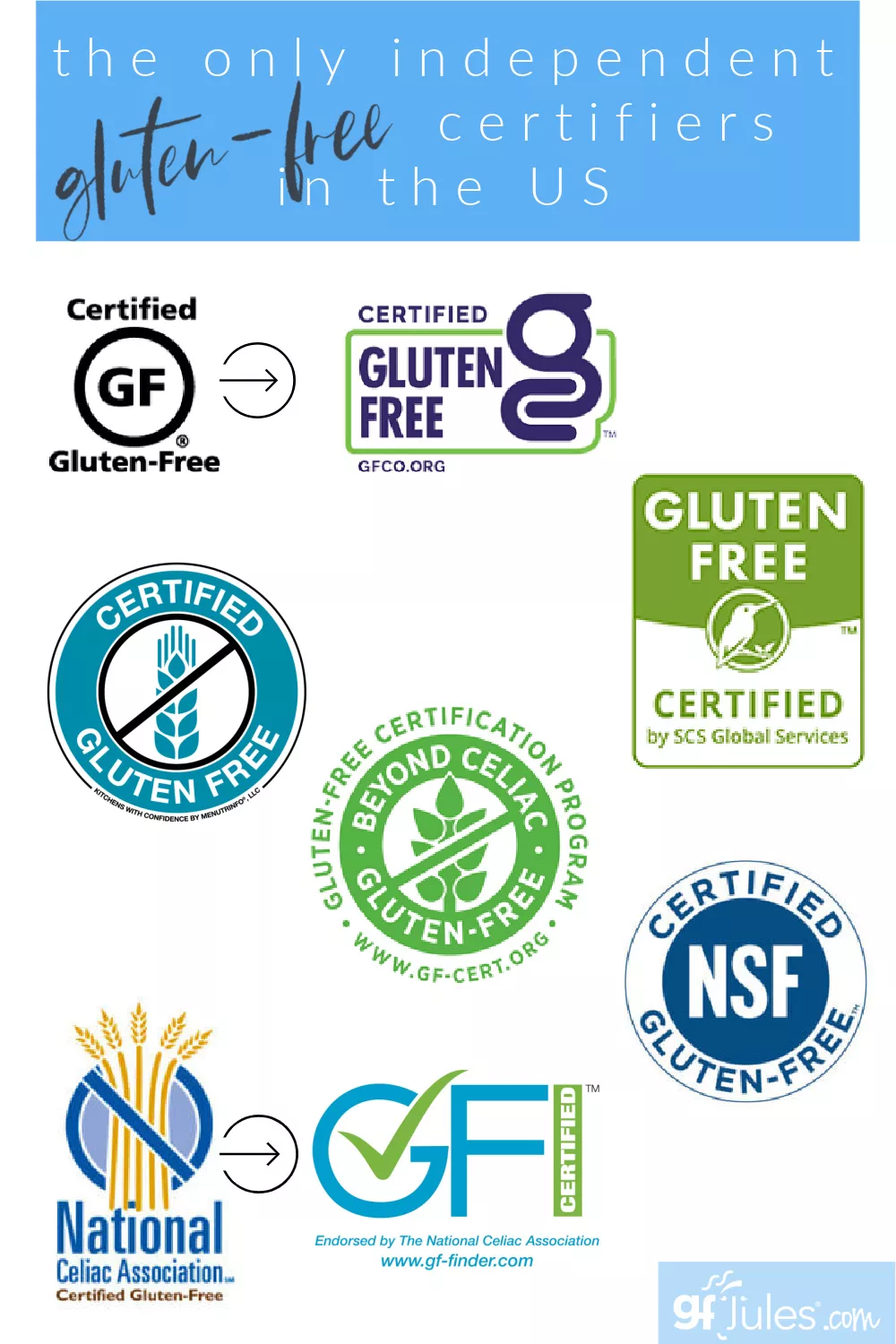
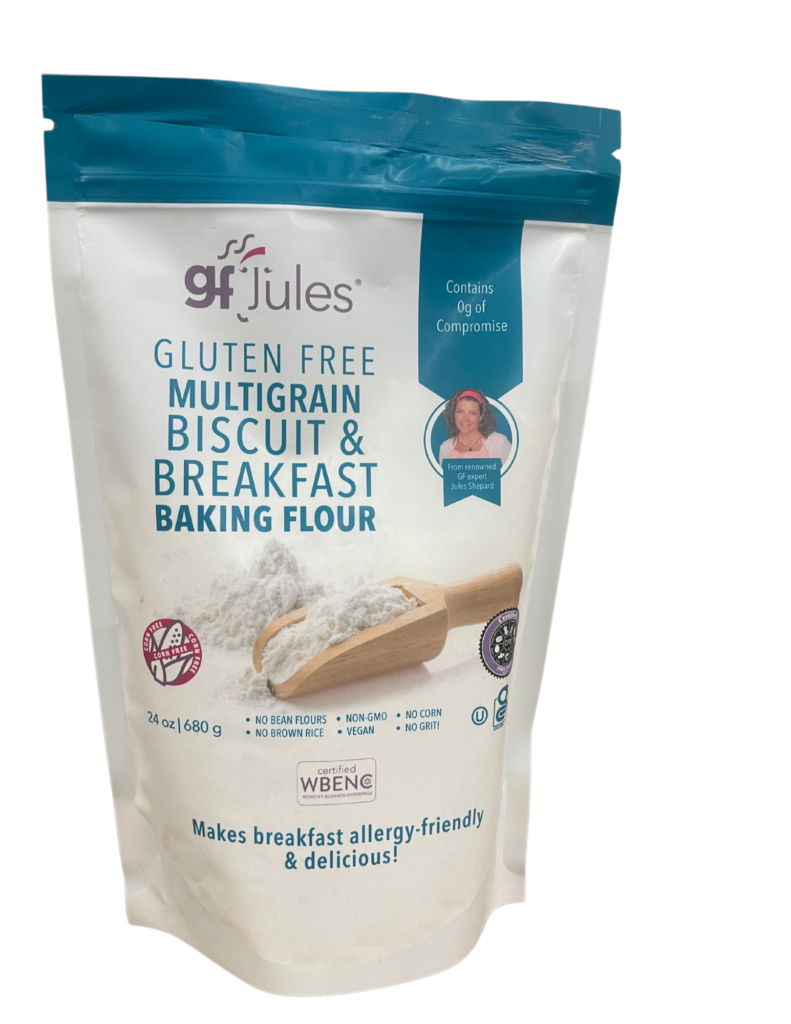
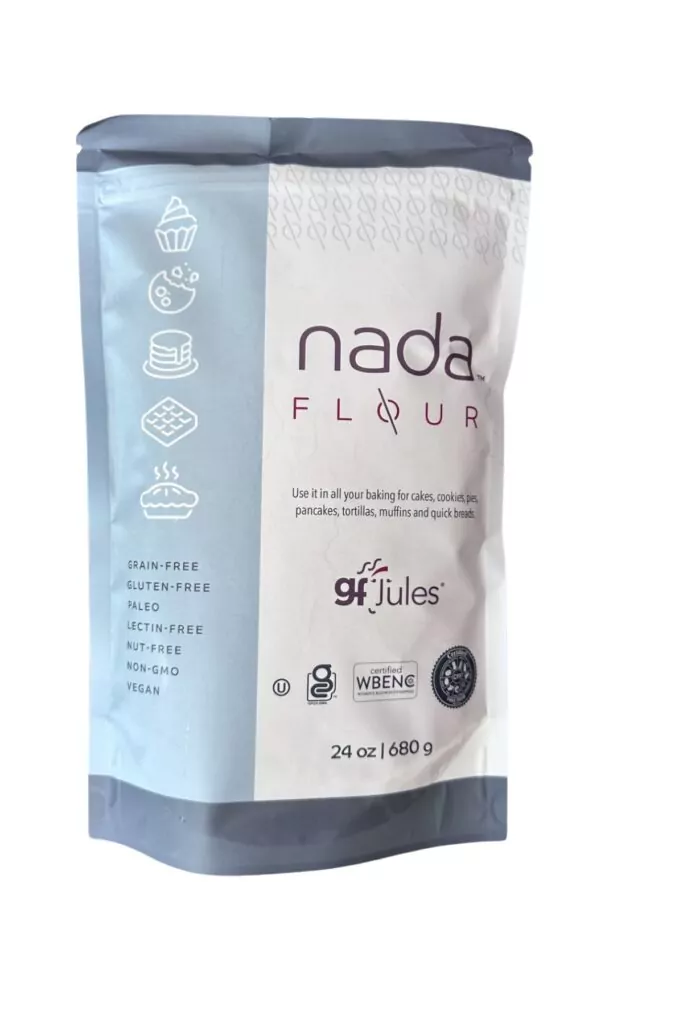


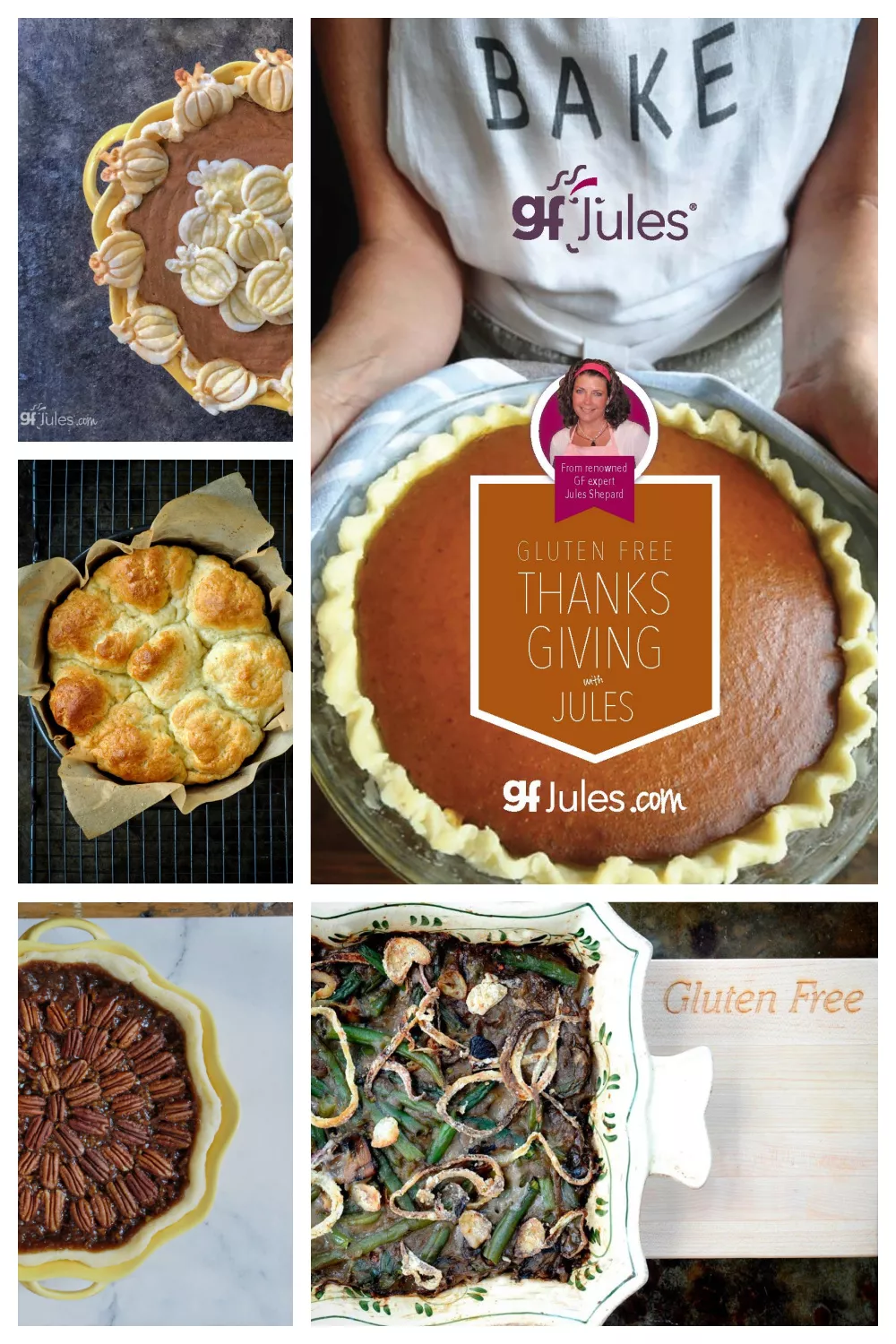



















I am struggling and have had some flops. I currently have 3 brands of gf 1:1 flour on my shelf. Can I dump all three of these into my flour container & bake cookies? I have learned the hard way by not doing what my mom always did—make a test cookie—always—no matter how many times you’ve made the recipe! Susan
The test cookie is always a good idea! Moms are the best, with their tips, aren’t they??
As for dumping the flours in a bin and working from that, I would recommend against it because they all work differently and you’ll wind up with a “meh” mixture. I feel the need to not waste, but I would save those 3 bags for things that don’t matter so much like “flouring” pans and counters, coatings, or specific recipes you’ve tried with each blend that you know work well. Each manufacturer will have recipes they suggest for their blend and hopefully they’re at least decent! One might have a good cookie, another a banana bread. Just try to remember which is good for what and use them up, then simplify your life and only buy ONE! Of course I believe my gfJules Flour is the one that works best for everything (check the reviews and see for yourself), but if you find another that you love for everything, then stick with it! My motto is that you should live your best gluten free life without compromise, and part of that lifestyle is not having to buy a different flour for every kind of recipe! 🙂
~jules
Hi Jules
Your recipes look mouthwatering but is your flour available in Montreal Canada. I could not find a seller. Can you propose a flour mix I can make myself? Shipping your flour here is cost prohibitive! Other flour mixes I’ve tried just don’t make anything really delicious.
Hi Elena, we’ve worked hard to get great shipping rates for our friends in Canada through our website shop. Either put items into your cart and check the price or simply email Haley@gfJules.com and she’ll work with you to get the best rate!
~jules
I noticed you state that arrowroot flower is”…similar to cornstarch, it’s used in combination with other gluten free flours or for thickening and to add crunch.”…I am wondering…I make my own taco seasoning and it uses ap flour (not much) for thickening…Would arrowroot be a good substitute?…I am worried about it imparting a flavor profile that would affect the seasoning…if not arrowroot, what would you suggest?…Thank you…
Hi David, arrowroot doesn’t have a taste or flavor to worry about affecting the seasoning, so I think you’re ok there, but it will thicken at a different rate than an all purpose flour does. If your seasoning recipe already calls for AP flour though, you could just sub in my gfJules All Purpose Flour since it doesn’t have any flavor or texture, either. Would be an easy switch!
~jules
Where is your gluten flour available in Perth?
Hi Jules
Can I buy the flour anywhere in Australia
Hi Erica, we ship all over the world — even to Australia! — but it can be expensive. There is a place in Perth that buys quite a lot of our flour. Do you live anywhere near there? Also, a store in Singapore that ships which may offer cheaper shipping options. Otherwise, put some products in your cart and play around with the shipping costs, as they do change. My understanding is that there is a sweet spot for shipping where the first 5 pounds or so are the most expensive, but after that it gets cheaper to add more to your cart, but it all depends on where you live and the weight of what you are purchasing. I hope that helps!
~jules